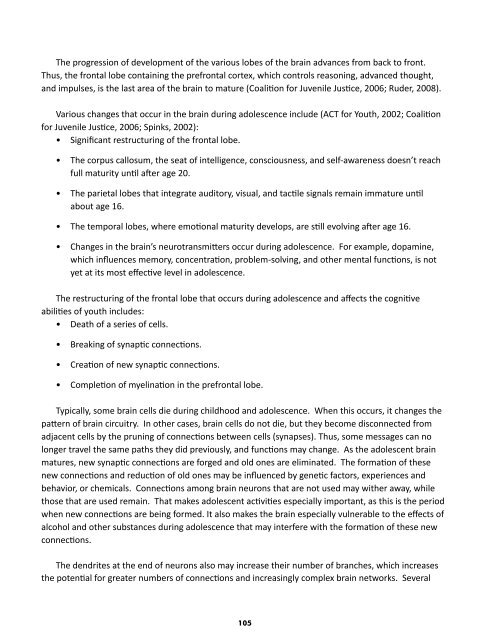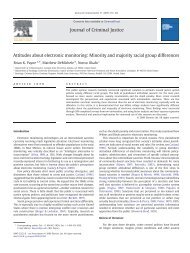Intervention Principles and Practice Guidelines for - Underage ...
Intervention Principles and Practice Guidelines for - Underage ...
Intervention Principles and Practice Guidelines for - Underage ...
You also want an ePaper? Increase the reach of your titles
YUMPU automatically turns print PDFs into web optimized ePapers that Google loves.
The progression of development of the various lobes of the brain advances from back to front.<br />
Thus, the frontal lobe containing the prefrontal cortex, which controls reasoning, advanced thought,<br />
<strong>and</strong> impulses, is the last area of the brain to mature (Coalition <strong>for</strong> Juvenile Justice, 2006; Ruder, 2008).<br />
Various changes that occur in the brain during adolescence include (ACT <strong>for</strong> Youth, 2002; Coalition<br />
<strong>for</strong> Juvenile Justice, 2006; Spinks, 2002):<br />
• Significant restructuring of the frontal lobe.<br />
• The corpus callosum, the seat of intelligence, consciousness, <strong>and</strong> self-awareness doesn’t reach<br />
full maturity until after age 20.<br />
• The parietal lobes that integrate auditory, visual, <strong>and</strong> tactile signals remain immature until<br />
about age 16.<br />
• The temporal lobes, where emotional maturity develops, are still evolving after age 16.<br />
• Changes in the brain’s neurotransmitters occur during adolescence. For example, dopamine,<br />
which influences memory, concentration, problem-solving, <strong>and</strong> other mental functions, is not<br />
yet at its most effective level in adolescence.<br />
The restructuring of the frontal lobe that occurs during adolescence <strong>and</strong> affects the cognitive<br />
abilities of youth includes:<br />
• Death of a series of cells.<br />
• Breaking of synaptic connections.<br />
• Creation of new synaptic connections.<br />
• Completion of myelination in the prefrontal lobe.<br />
Typically, some brain cells die during childhood <strong>and</strong> adolescence. When this occurs, it changes the<br />
pattern of brain circuitry. In other cases, brain cells do not die, but they become disconnected from<br />
adjacent cells by the pruning of connections between cells (synapses). Thus, some messages can no<br />
longer travel the same paths they did previously, <strong>and</strong> functions may change. As the adolescent brain<br />
matures, new synaptic connections are <strong>for</strong>ged <strong>and</strong> old ones are eliminated. The <strong>for</strong>mation of these<br />
new connections <strong>and</strong> reduction of old ones may be influenced by genetic factors, experiences <strong>and</strong><br />
behavior, or chemicals. Connections among brain neurons that are not used may wither away, while<br />
those that are used remain. That makes adolescent activities especially important, as this is the period<br />
when new connections are being <strong>for</strong>med. It also makes the brain especially vulnerable to the effects of<br />
alcohol <strong>and</strong> other substances during adolescence that may interfere with the <strong>for</strong>mation of these new<br />
connections.<br />
The dendrites at the end of neurons also may increase their number of branches, which increases<br />
the potential <strong>for</strong> greater numbers of connections <strong>and</strong> increasingly complex brain networks. Several<br />
105

















